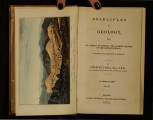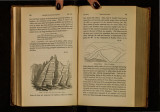| OCR Text |
Show 100 NEWER PLIOCENE PERIOD. (Ch. VIII. w•tt hm• the last two t 11 ousan d yeat.s . Of the eiO'hty most con- o spt· cuous mm· ot· cones w h1' c I1 a d orn 1't s flank.s ' .o nly one. of the largest, Monti Rossi, has been produced wtthm t.he times of authentic history. Even this hill, thrown up m the year 1669, although 450 feet in height, only ranks as ~ cone of second magnitude. Monte Minardo, near Bronte, nses, even now, to the height of 750 feet, although its base has been elevated by more modern lavas and ejections. The dimensions of these larger cones appear to bear testimony to paroxysms of volcanic activity, after which we may conclude, from analogy, that the fires of Etna remained dormant for many years-since nearly a century of rest has sometimes followed a violent eruption in the historical era. · It must also be remembered, that of the small number of eruptions which occur in a century, one only is estimated to issue from the summit of Etna for every two that proceed from · the sides. Nor do all the lateral eruptions give rise to such cones as would be enumemted amongst the smallest of the eighty hills above enumerated; some produce merely insignificant monticules, soon destined to be buried, as we before explained. How many years then must we not suppose to have been expended in the formation of the eighty cones? It is difficult to imagine that a fourth part of them have originated during the last thirty centuries. But if we conjecture the whole of them to have been formed in twelve thousand years, how inconsiderable an era would this portion of time constitute in the history of the volcano! If we could strip off from Etna all the lateral monticules now visible, together with the lavas and scorire that have been poured out from them, and from the highest cratet·, during the period of their growth, the diminution of the entire mass would be extremely slight! Etna might lose, perhaps, several miles in diameter at its base, and some hundreds of feet in elevation, but it would still be the loftiest of Sicilian mountains, studded with other cones, which would be recalled, as it were, into existence by the removal of the rocks under which they are now buried. Ch. VITI.] DILUVIAL WAVES. 101 There seems nothing in the deep sections of the Val del Bove, to indicate that the lava currents of remote periods were greater in volume than those of modern times; and thore are abundant proofs that the countless beds of solid rock and scorire were accumulated, as now, in succession. On the grounds, therefore, already explained, we must infer that a mass, eight thousand or nine thousand feet in thickness, must have required a·n immense series of ages anterior to our historical periods, for its growth ; yet the whole must be regarded as the product of a modern portion of the newer Pliocene epoch. Such, at least, is the conclusion that we draw from the geological data already detailed, which show that the oldest parts of the mountain, if not of posterior date to the marine strata which are visible around its base, were at least of coeval origin. fVhether signs of Diluvial Waves are observable on Etna.Some geologists contend, that the sudden elevation of large continents from beneath the waters of the sea, have again and again produced waves which have swept over vast regions of the earth, and left enormous rolled blocks strewed over the surface*. 'J'hat there are signs of local floods of extreme violence, on various parts of the surface of the dry land, is incontrovertible, and in the former volumes we have pointed out causes which must for ever continue to give rise to such phenomena; but for the pmofs of these general cataclysms we have searched in vain. It is clear that no devastating wave has p~ssed over the forest zone of Etna, since any of the lateral cones before mentioned were thrown up ; for none of these heaps of loose sand and scorioo could have resisted for a moment the denuding action of a violent flood. To some, perhaps, it may appear that hills of such incoherent materials cannot be of immense antiquity, because the mere action of the atmosphere must, in the course of several thousand years, have obliterated their original forms. But there is no weight in this objection, for the older hills are covered with * Sedgwick, Anniv. Address to the Geol, Soc., p. 35. Feb. 1831. |






























































































































































































































































































